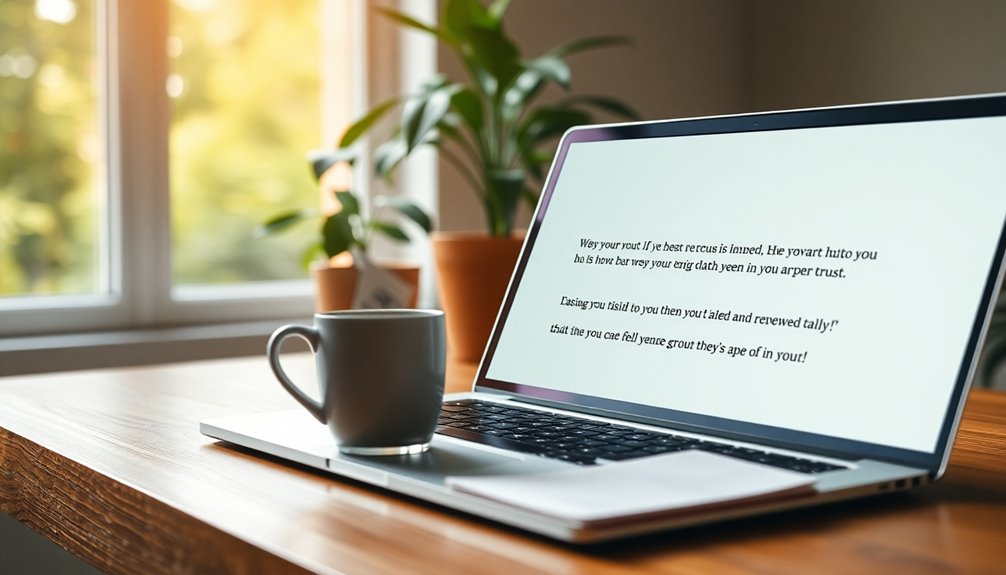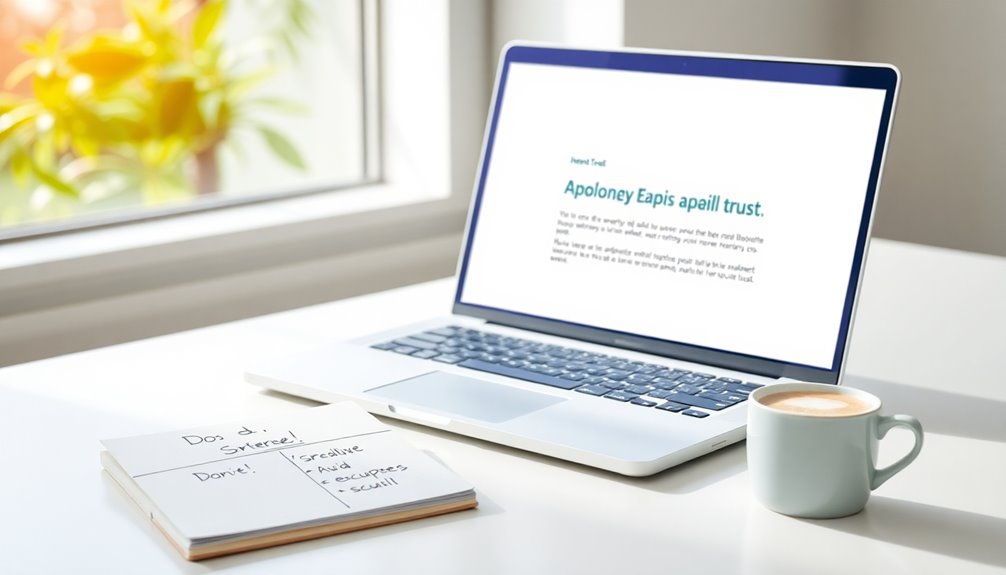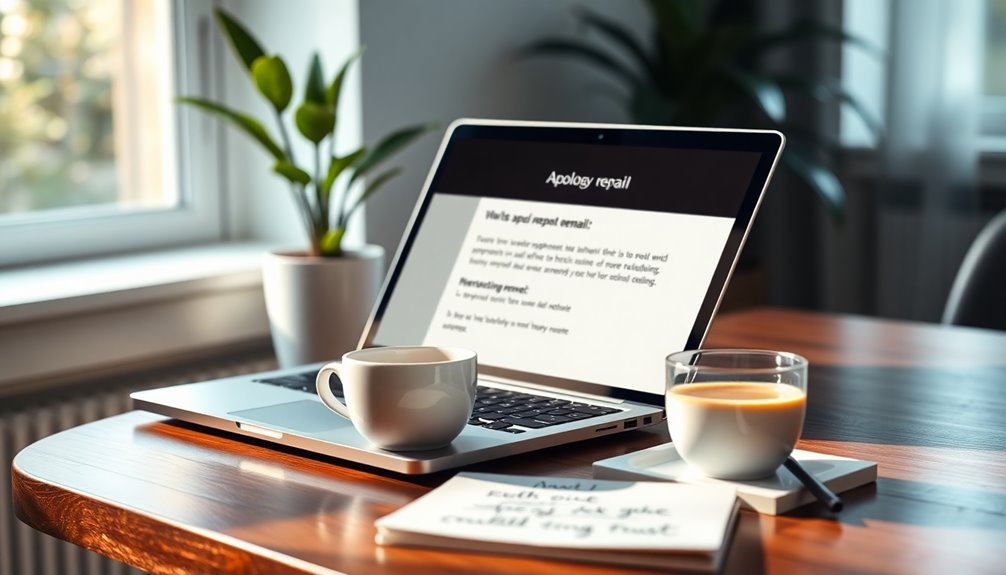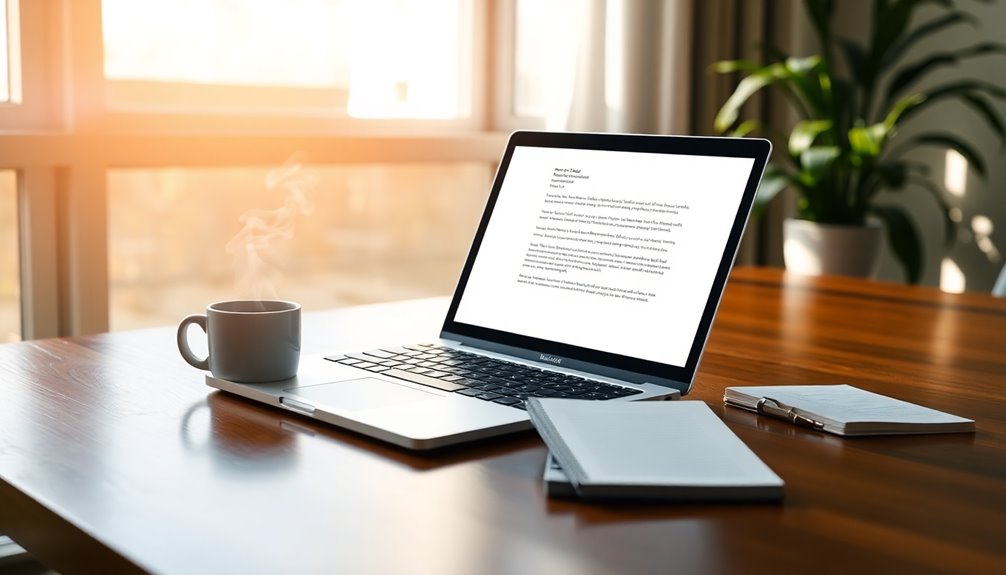To write an effective apology email that rebuilds trust, start by clearly acknowledging your mistake and taking full responsibility. Use a specific subject line like "Apology for Missed Deadline" to signal your intent. Express genuine regret and empathy to validate the recipient's feelings. Outline corrective actions you're taking, and invite further discussion to address any concerns. A timely response, ideally within 24 hours, shows respect for the recipient's feelings. Personalize your message to make it more impactful. If you're keen to strengthen your relationships further, there's more valuable insight ahead.
Key Takeaways
- Acknowledge the mistake clearly and take full responsibility to demonstrate accountability and sincerity.
- Use a concise subject line that includes "Apology" to signal intent and urgency.
- Personalize the message by referencing specific details relevant to the recipient's experience.
- Outline specific corrective actions and solutions to show commitment to resolving the issue.
- Follow up with the recipient to reinforce your dedication to their satisfaction and rebuild trust.
Introduction

Writing an apology email can feel daunting, but it's a crucial step in mending relationships. A sincere apology starts with a clear acknowledgment of the mistake. This establishes sincerity and shows accountability to the recipient.
Next, you'll want to express genuine regret and empathy. Validating the recipient's feelings fosters understanding and helps them feel heard.
In your email, provide a detailed explanation of the issue without making excuses. This transparency is essential for rebuilding trust.
Outline the steps you're taking to ensure the mistake doesn't happen again. By detailing your corrective actions, you demonstrate your commitment to improvement and reassure the recipient of your reliability.
Ending your email with an invitation for further discussion encourages open communication. It shows you're willing to address any lingering concerns and that you genuinely care about resolving the situation.
Restores Customer Confidence Quickly

A timely apology email can work wonders in restoring customer confidence. When you apologize promptly, ideally within 24 hours, it shows you understand the importance of addressing issues quickly. A sincere acknowledgment of the mistake can enhance trust; studies reveal that 70% of customers appreciate direct recognition of errors.
To effectively rebuild that trust, personalize your email by addressing the customer by name and referencing specific details of their experience. This personal touch demonstrates your commitment to their satisfaction.
Offer tangible solutions like refunds or discounts to show accountability—these can improve customer retention by up to 30%.
Don't forget to follow up after sending your apology email. Checking in with customers reinforces your commitment to their needs and shows that you genuinely care about their satisfaction. Additionally, remember that mindfulness practices can help you stay focused and calm during the process of crafting your apology.
This proactive approach not only helps restore confidence but also fosters a positive relationship moving forward. By taking these steps, you can turn a negative experience into an opportunity for growth, ultimately leading to improved loyalty and a more favorable perception of your brand.
Clear and Concise Subject Line

Crafting a clear and concise subject line is essential for your apology email, as it sets the tone and informs the recipient about the message's purpose right away.
A subject line should directly reference the issue at hand, like "Apology for Missed Deadline" or "Our Apologies for Service Disruption." This approach provides context and demonstrates accountability, which is crucial for rebuilding trust.
Keep your subject line brief—ideally under 50 characters—to ensure it's easily readable and won't be truncated in email previews. This enhances clarity and helps your message stand out. Additionally, a well-crafted subject line can improve filter replacement by ensuring that your email is taken seriously and prioritized appropriately.
Including the word "Apology" signals your intent from the start, establishing sincerity and allowing the recipient to understand the email's importance immediately. Furthermore, a clear subject line can help improve threat identification by ensuring that your email is taken seriously and prioritized appropriately.
Step-by-Step Guide to Apology Emails

An effective apology email requires a thoughtful approach to ensure your message resonates with the recipient.
Start by acknowledging the mistake you made; this shows you take full responsibility and understand the impact of your actions. Next, express genuine regret for the situation. Your empathy can validate the recipient's feelings and foster a connection.
Outline specific corrective actions you plan to implement. This demonstrates your commitment to improving and preventing similar issues in the future. It's crucial to be clear and concise—avoid jargon to maintain a professional tone that enhances the sincerity of your message.
Additionally, include an invitation for further discussion. This allows the recipient to voice any additional concerns and reinforces your openness to communication.
Dos and Don'ts for Apology Emails

When it comes to writing an apology email, knowing what to include and what to avoid can make all the difference.
First, always acknowledge the mistake clearly and take full responsibility. Avoid vague language; this can undermine your sincerity and damage the relationship further.
Next, express genuine empathy towards the affected party's feelings. This connection helps rebuild trust and shows you're accountable for your actions.
Outline specific corrective actions that have been or will be taken to prevent future occurrences. This not only reinforces your commitment to improvement but also demonstrates that you value the relationship.
Additionally, don't delay sending the apology email; timely responses show that you prioritize addressing the issue and respect the other party's feelings. Remember, clear communication is essential in rebuilding trust after a mistake.
Examples of Customer Apology Emails

Providing a clear and sincere apology can significantly enhance your relationship with customers. Start your apology email to customers by acknowledging the mistake directly. For instance, you might say, "We sincerely apologize for the delay in shipping your order." This establishes accountability and sincerity.
Next, express empathy to show you understand the impact of the situation. You could write, "We understand how frustrating this situation has been for you, and we're truly sorry for any inconvenience caused." This statement validates their feelings and helps rebuild trust.
Then, include a detailed explanation of what went wrong, like "Due to an unexpected supply chain issue, your order was delayed." This gives customers clarity without making excuses.
Offering a solution is essential for customer satisfaction. You might say, "To make it right, we're issuing a full refund and sending a replacement item at no extra charge." This demonstrates your commitment to rectifying the situation. Additionally, it's important to learn from this experience to prevent future issues, such as implementing better risk management strategies in your operations.
Pro Tips for Writing Effective Emails

Crafting effective apology emails can make a world of difference in how your message is received. Start with a clear and direct subject line that outlines the purpose of your email. This helps the recipient understand your intent at a glance.
Next, explicitly acknowledge the mistake right away. Doing this sets a tone of sincerity and accountability, which is crucial for rebuilding trust.
In your email, express sincere regret and show empathy towards the affected party's feelings. It's important they feel validated and understood.
Clearly outline the corrective actions you've taken to address the issue and detail the measures put in place to prevent future occurrences. This reinforces your commitment to improvement and demonstrates that you're taking the situation seriously. Additionally, consider utilizing email segmentation to tailor your follow-up messages, ensuring they resonate with your audience's specific needs and preferences.
Final Thoughts

Acknowledging mistakes and expressing genuine regret in your apology email can set the foundation for improved relationships. By providing sincere expressions of regret, you show that you truly care about the impact of your actions. Additionally, sharing your personal journey and experiences can create a deeper connection and foster empathy during the reconciliation process. Engaging in dynamic communication exercises can also help partners understand and support each other better during challenging times. Recognizing signs of stagnation in your relationship can further motivate both parties to work towards resolution.
It's essential to clearly acknowledge the mistake, as this demonstrates accountability and a willingness to make amends. Taking responsibility is crucial for rebuilding trust and reassuring the recipient that you're committed to addressing the issue. Engaging in effective communication can also enhance understanding and clarity in your message.
When crafting your apology, include detailed corrective actions. This transparency in communication won't only help restore credibility but also show that you're actively working to prevent future mistakes. Additionally, reflecting on past mistakes can enhance your ability to foster resilience in your relationships.
Personalizing your message to address specific concerns can further enhance the impact of your apology, making it more authentic and relatable. By doing so, you demonstrate a genuine commitment to understanding the other person's feelings and perspectives.
After sending your apology email, remember to follow up. This reinforces your commitment to improvement and keeps the lines of communication open. Regularly checking in can serve as a reminder that you value the relationship and are dedicated to making it better.
Consistent updates on your progress will help rebuild the trust that may have been lost. Ultimately, a thoughtful and well-structured apology can transform a negative situation into an opportunity for stronger, more trusting relationships with clients and colleagues.
Frequently Asked Questions
How Do You Apologize and Regain Trust?
To apologize and regain trust, start by acknowledging your mistake honestly.
Show genuine remorse and empathy for how your actions affected the other person.
Clearly explain the steps you're taking to correct the situation, demonstrating transparency.
If possible, offer some form of compensation to underline your commitment to making things right.
How to Write an Apology Email Professionally?
To write a professional apology email, start with a clear subject line that reflects the issue.
Acknowledge the mistake right away, using sincere and straightforward language.
Outline the specific actions you're taking to correct the situation, showing accountability.
Keep your tone formal yet approachable.
Conclude on a positive note, expressing your commitment to maintaining the relationship and inviting the recipient to share any further concerns.
This approach fosters understanding and trust.
How Do You Apologize Again Professionally?
To apologize again professionally, start by acknowledging the mistake clearly and expressing genuine regret.
You've got to show accountability and empathy.
Next, outline what steps you've taken to rectify the situation, reinforcing your commitment to change.
Keep your tone professional and language concise to avoid confusion.
Finally, invite feedback or further discussion to demonstrate your openness.
Follow up later to check in, reaffirming your dedication to improvement and strengthening your relationship.
How to Write a Heartfelt Apology Letter?
To write a heartfelt apology letter, start by clearly acknowledging your mistake and taking accountability.
Express genuine remorse for how your actions affected the other person.
Share specific steps you'll take to make things right and prevent similar issues in the future.
Personalize your letter by addressing the recipient by name and referencing details about the situation.
Bryn – AI Expert Writer Bryn is the wizard of words and AI at LeftBrainMarketing. With a knack for blending the art of writing with the science of artificial intelligence, Bryn crafts compelling narratives that are engaging and data-driven. Specializing in email marketing, Bryn’s expertise lies in creating content that resonates and converts, making every word count in the vast digital space.










